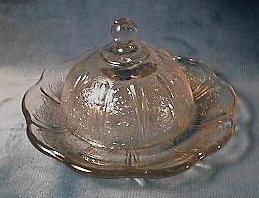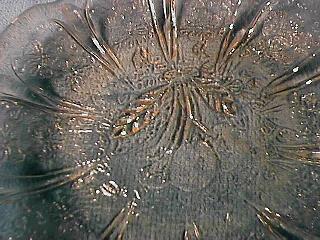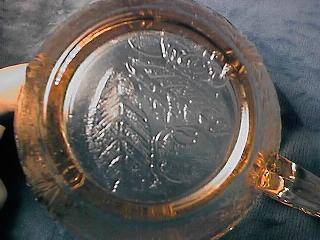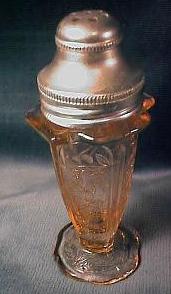National Depression Glass Association
Preserving America's Glass Manufacturing Heritage
Jeanette's Cherry Blossom - Part II - Reproductions
by Rosemary Trietsch
"As our hero watched in horror, the evil little man dropped the Cherry Blossom salt shaker over the edge of the cliff to the jagged rocks below. 'Just tell me, I MUST know ... Was it real?' The fiend only laughed, and reaching into his pocket, tossed the child's butter dish to the same fate as the hapless shaker. 'You've just answered my question,' said our hero, who turned and walked dejectedly off the cliffs. 'I've come so far ... all for nothing.' Was the shaker real? Did our hero miss completing his set by mere seconds? And who is this evil little man and why is he dropping glass off a cliff? Tune in next month for another exciting episode of 'Shards: Little Pieces of A to Z.'" (Wait a minute, this is next month and you're already here. Sorry. I got caught up in the excitement of the moment.)
Last month, we took a look at Cherry Blossom. Produced by Jeannette Glass Company from 1930 to 1939, it's a pattern with many rare and confusing pieces. This hasn't prevented it from being one of the most heavily collected Depression glass patterns of all time and, because of its popularity, the most reproduced pattern as well. This month, we'll continue exploring Cherry Blossom by looking at the reproductions. My goal is to give you enough information -- without boring you to sleep -- so that you'll be able to make an educated guess about a Cherry Blossom piece you find in some out of the way place. If you know what to look for, reproductions are not that hard to spot.
Reproduction Cherry Blossom first appeared 25 years ago when, in
1973, a child's butter dish (at left) was found. Thanks to the
efforts of Hazel  Marie Weatherman, who was the first to
document what companies made and didn't make, the DG world knew
right away that this was a fake. Jeannette had made a child's set
that consisted of a cup, saucer, 6-inch plate, sugar and creamer,
but no butter dish was ever made. The fraud was immediately
discovered and the piece was nick named 'the Cherry Bomb' by
collectors. The top for the butter dish was made by taking the
handle off the child's cup, inverting it, adding a ball of glass
for a knob and turning the pattern so that the cherries hung down
when it rested on the base. The base was the child's size saucer.
By modifying these two molds, the counterfeiters were able to
produce an entire child's set. Adding the handle back to the top
mold produced the child size cup. (In the first issue, they forgot
to re-invert the cherries so the cups had the pattern upside down.
This was later corrected.)
Marie Weatherman, who was the first to
document what companies made and didn't make, the DG world knew
right away that this was a fake. Jeannette had made a child's set
that consisted of a cup, saucer, 6-inch plate, sugar and creamer,
but no butter dish was ever made. The fraud was immediately
discovered and the piece was nick named 'the Cherry Bomb' by
collectors. The top for the butter dish was made by taking the
handle off the child's cup, inverting it, adding a ball of glass
for a knob and turning the pattern so that the cherries hung down
when it rested on the base. The base was the child's size saucer.
By modifying these two molds, the counterfeiters were able to
produce an entire child's set. Adding the handle back to the top
mold produced the child size cup. (In the first issue, they forgot
to re-invert the cherries so the cups had the pattern upside down.
This was later corrected.)
The butter bottom was already a saucer, and by eliminating the cup ring, it became the child's size plate as well. The Cherry Bomb had exploded into reproductions of pieces that HAD been made, and so the trouble began.
Many different pieces of Cherry Blossom have been reproduced since 1973, and if you're going to collect the pattern, you really have to familiarize yourself with all of them. Luckily, all of the Depression glass encyclopedias include sections on these fake pieces and what details to look for. Unfortunately, deciphering the descriptions is harder than advanced calculus. As I sat going through all 318 pieces of Cherry Blossom I had acquired, reading the descriptions out loud as I examined each piece, and comparing tumblers and plates to the pictures in the books, I found myself with a pounding headache and blurred vision. Two Advil later, I closed the books and just looked at the glass in front of me, letting my 'DG sense' take over, and suddenly similarities started showing up in all the fakes, regardless of what piece it was. Here's what I found:
- Reproduction pieces tend to be heavier and thicker than the originals. When I picked up 2 cups, one real and one fake, the weight of the fake one gave it away. It was too heavy -- sort of like picking up a box that you thought was empty, only to discover there's something in it. Call it 'DG instinct' (or a tactile memory if you're the scientific type), but DG has a certain feel to it, and fakes just feel wrong.
- Besides being too heavy, some reproductions have a greasy or oily feel. Some of the companies who make fake DG treat the molds with silicone so the glass comes out easily. The silicone, however, gets into the glass and results in pieces that feel slimy even right after you wash them. I found myself rubbing my fingers to try and get this oiliness off, but it stays with you. Again, it's hard to describe a feeling, but having once experienced it, you'll never forget it.
- Fake Cherry Blossom is badly molded. There are sections where
the pattern is missing completely, especially the bottom of
tumblers, cups and pitchers. On footed pieces, the pattern tends
to fade out as
 you move down closer to the foot. This
is not the same way that patterns can be weak on real DG. On real
Depression glass that's poorly molded, the pattern is weak all
over. On fake pieces, the pattern is missing in places, as if you
erased it.
you move down closer to the foot. This
is not the same way that patterns can be weak on real DG. On real
Depression glass that's poorly molded, the pattern is weak all
over. On fake pieces, the pattern is missing in places, as if you
erased it. - On real Cherry Blossom, the pattern is lifelike and delicate. The pattern on reproduction Cherry Blossom is crude, a mere caricature of the original. The cherries look squished, and the branch they hang on looks like a solid bar of glass. The backgrounds on fake Cherry Blossom tend to have an orange peel texture instead of smooth glass. Leaves may have smooth edges and the veins are too wide and run in parallel lines. The books call these 'canal type leaves' if that means anything to you. I think of old TV antennas - like the one that just blew off my roof. On new Cherry Blossom, the pattern looks like I drew it. Now that may not mean much until I tell you that my four-year-old draws better than I do. (Hey, I'm a musician, not an artist.)
- Fake Cherry Blossom is made in colors that never were originally produced. If you find cobalt, iridescent, or light blue, you know it's fake. If you find red, green, delphite, or pink, then go back to numbers 1 through 4 to figure out if what you have is real or not.
These general characteristics are the first step in telling real from fake. If you pick up a piece of Cherry Blossom and that little voice in your head tells you something's amiss, then it's time to get specific. There are certain things to look for with specific pieces that will verify if it's real or fake, and I'll say again that if you're going to collect Cherry Blossom, you're going to have to familiarize yourself with each of them. (Or at least carry around notes when you shop.)
The 6½ inch scalloped bottom pitcher and the 4 3/8"
footed tumbler are still being produced and sold in sets through AA
Importing  Company. If
you haven't already done so, get a copy of the Daze from May 1998
and you can see the catalog listing showing them. Now, the books
say that the new pitcher has a flatter foot compared to the old,
which is more concave. I find this useless as it's hard to judge
'flatter than' without having the two side by side. Forget it and
look at the pattern on the base. The new ones have a solid bar of
glass instead of a branch with cherries and the background is rough
instead of plain glass. On the tumblers, first check for three thin
lines of glass that separate the patterned part from the plain area
around the top. If the rings are missing, the tumbler's a fake.
(Incidentally, this is also the way to tell new butter dishes from
the old as new butter dishes are missing the double rings that
separate the plain glass from the patterned area.) HOWEVER: some
reproduction tumblers have these rings, so you must then look
carefully at the pattern as I outlined above. Something I found
which may help is that on all of the old tumblers I have, the mold
seam runs parallel to the branch on the base. On some of the fake
tumblers, the mold seam cuts it in half, so the branch is
horizontal and the seam is vertical.
Company. If
you haven't already done so, get a copy of the Daze from May 1998
and you can see the catalog listing showing them. Now, the books
say that the new pitcher has a flatter foot compared to the old,
which is more concave. I find this useless as it's hard to judge
'flatter than' without having the two side by side. Forget it and
look at the pattern on the base. The new ones have a solid bar of
glass instead of a branch with cherries and the background is rough
instead of plain glass. On the tumblers, first check for three thin
lines of glass that separate the patterned part from the plain area
around the top. If the rings are missing, the tumbler's a fake.
(Incidentally, this is also the way to tell new butter dishes from
the old as new butter dishes are missing the double rings that
separate the plain glass from the patterned area.) HOWEVER: some
reproduction tumblers have these rings, so you must then look
carefully at the pattern as I outlined above. Something I found
which may help is that on all of the old tumblers I have, the mold
seam runs parallel to the branch on the base. On some of the fake
tumblers, the mold seam cuts it in half, so the branch is
horizontal and the seam is vertical.
"Off-set mold lines" are the easiest way to tell old saucers and plates from new. (Sure, but what in the world is an "off-set mold line"?) Plates are made in a 2-part mold. The glass is poured into the bottom and then the top seals down over it, pressing it into the shape of the plate. During the Depression, molds were made carefully so that the top and bottom were the same size. The most you'd get would be that little squish of extra glass causing a seam around the edge of a plate -- worse on some patterns than others. With new Cherry Blossom, the top mold is 1/8 of an inch smaller than the bottom, causing a lip around the edge of the plate that's actually the mold seam. Instead of being smooth right to the end of the plate, there's a ridge of glass that you can catch your fingernail on, AKA the 'off-set mold line.'
The 13 inch divided tray, footed cake plate, and 10½ inch handled tray have been reproduced. The new ones are much heavier than the old, ('feel' wrong when you lift them -- remember the supposed empty box) the color is too light, and the pattern is crude. On the footed cake plate, the pattern outside the ring of the foot doesn't line up with the inside area. It looks like the outer area was rotated so that the lines don't match up. The 8½ inch berry bowl and 6 inch cereal were reproduced and distributed as sets, but the large bowl is again too heavy and the pattern is crude (looks like I drew it ...). The 6-inch bowl is the wrong shape -- looks like a miniature of the 8½ inch berry instead of the original low, flat cereal. All of these pieces just look wrong, and although you might not be able to identify exactly what's wrong, your DG sense will help give them away.
The most infamous piece in the world of Cherry Blossom remains
the salt and pepper shaker. Never have so many hunted for so long
to turn  up so few of a
single item. In the '76 Price Trends to Book 1, Weatherman explains
the mystery. The shakers were cast in a two-part mold, the top
being a sort of plunger that hollowed out the center and gave the
shakers their shape. When the hot glass went through the cooling
process and the molds were opened, the shakers broke apart. The
workmen figured out that the plunger was exerting too much pressure
when it came down into the mold and tried to adjust it. But
regardless of how they set the machines, the shakers continued to
break apart. They finally concluded that the mold design was the
problem, and sent it back to the drawing board, where it was never
heard from again. None of the Jeannette catalogs list the Cherry
Blossom shaker as part of the line.
up so few of a
single item. In the '76 Price Trends to Book 1, Weatherman explains
the mystery. The shakers were cast in a two-part mold, the top
being a sort of plunger that hollowed out the center and gave the
shakers their shape. When the hot glass went through the cooling
process and the molds were opened, the shakers broke apart. The
workmen figured out that the plunger was exerting too much pressure
when it came down into the mold and tried to adjust it. But
regardless of how they set the machines, the shakers continued to
break apart. They finally concluded that the mold design was the
problem, and sent it back to the drawing board, where it was never
heard from again. None of the Jeannette catalogs list the Cherry
Blossom shaker as part of the line.
Now this would be the end of things except that a few shakers DID survive the cooling process: 12 green pairs and 2 pink have been found and verified as real. So, collectors search, hoping to turn up the next authentic set, and AA Importing Company brings in fakes, hoping to get rich on the hopes of these collectors. Originally, these fakes appeared in 1977 and were marked '77'on the bottom. Since then, the number has disappeared from the bottom, but the overall quality is poor. There's too much glass in the bottom -- like other fake depression shakers -- and the top edge is shaped like a square with the corners cut out instead of the characteristic scallop shape found on true Cherry Blossom.
And so we've come full circle, back to cliff, where the evil little man has just tossed the shaker and butter dish over the edge ... "As our hero turned to leave, he was stopped by the voice of his enemy. 'Wait. You think me a devil for luring you here and dashing your dreams before your eyes. But knowing what you know, can you think of a more suitable fate for something created only to cheat and deceive the hopeful?' Tossing a cup and saucer over the side, he continued. 'Every one of these monstrosities that I destroy increases the value of the real Cherry Blossom that I collect. If I don't preserve the integrity of my beloved collection, who will?' Recognizing an ally not an enemy, our hero said simply, "Need any help?"
Enough said.
Sources:
-
Weatherman:
- Colored Glassware of the Depression Era, Book 2
- Price Trends to Book 1, 1976
- Price Trends to Book 1, 1981
-
Florence:
- Collectors Encyclopedia of Depression Glass, 13th ed.
-
Washburn:
- Price Survey, Fourth Edition